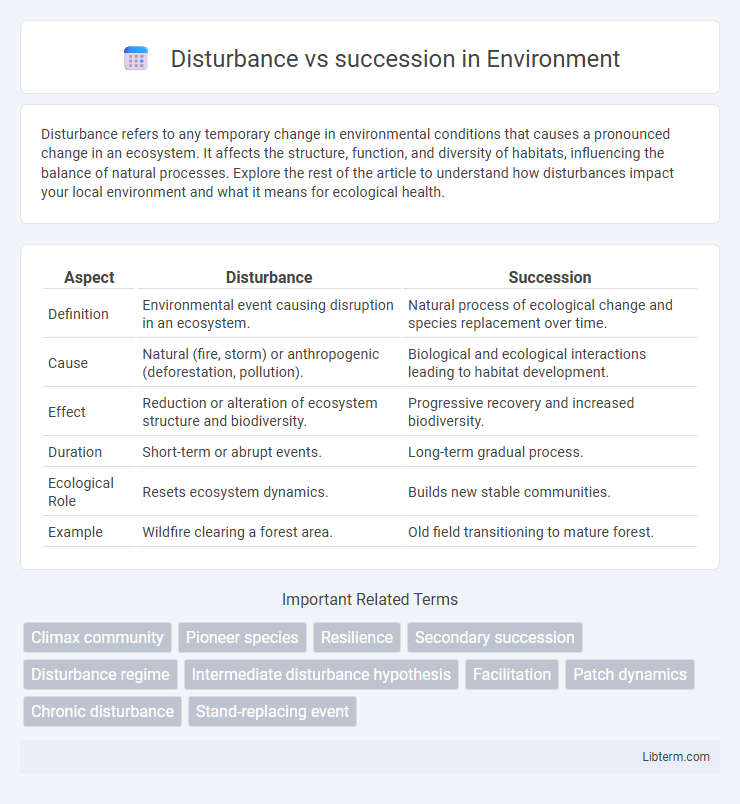Disturbance refers to any temporary change in environmental conditions that causes a pronounced change in an ecosystem. It affects the structure, function, and diversity of habitats, influencing the balance of natural processes. Explore the rest of the article to understand how disturbances impact your local environment and what it means for ecological health.
Table of Comparison
| Aspect | Disturbance | Succession |
|---|---|---|
| Definition | Environmental event causing disruption in an ecosystem. | Natural process of ecological change and species replacement over time. |
| Cause | Natural (fire, storm) or anthropogenic (deforestation, pollution). | Biological and ecological interactions leading to habitat development. |
| Effect | Reduction or alteration of ecosystem structure and biodiversity. | Progressive recovery and increased biodiversity. |
| Duration | Short-term or abrupt events. | Long-term gradual process. |
| Ecological Role | Resets ecosystem dynamics. | Builds new stable communities. |
| Example | Wildfire clearing a forest area. | Old field transitioning to mature forest. |
Introduction to Disturbance and Succession
Disturbance refers to any temporary change in environmental conditions that causes a pronounced change in an ecosystem, such as fires, storms, or human activities. Succession is the natural, gradual process by which ecosystems recover and develop after disturbance, progressing through stages from pioneer species to a stable climax community. Understanding disturbance and succession dynamics is essential for ecosystem management, biodiversity conservation, and predicting ecological responses to environmental changes.
Defining Ecological Disturbance
Ecological disturbance refers to any temporary change in environmental conditions that causes a pronounced change in an ecosystem, such as fires, storms, or human activities. These disturbances disrupt the structure, composition, or nutrient cycling of habitats, creating opportunities for species turnover and ecosystem change. Understanding disturbance dynamics is crucial for studying ecological succession, the gradual process by which ecosystems recover and evolve following such perturbations.
Types of Disturbance in Ecosystems
Ecosystem disturbances vary widely and include natural events such as wildfires, floods, storms, and volcanic eruptions, each altering habitat structure and species composition. Human-induced disturbances, like deforestation, pollution, and urbanization, disrupt ecosystem functions and biodiversity patterns. These disturbance types trigger ecological succession processes, where ecosystems gradually recover and re-establish community dynamics over time.
Understanding Ecological Succession
Disturbance in ecosystems refers to events that disrupt the structure or function of a community, such as wildfires, storms, or human activities, creating opportunities for ecological succession. Ecological succession is the natural, gradual process by which species composition in an ecosystem changes over time, leading to a stable climax community. Understanding the relationship between disturbance and succession highlights how disturbances reset successional stages, promoting biodiversity and ecosystem resilience through continuous species turnover and habitat regeneration.
Primary vs Secondary Succession
Primary succession occurs in lifeless areas where soil has not yet formed, such as after a volcanic eruption or glacier retreat, initiating a gradual buildup of organic material and pioneer species colonization. Secondary succession takes place in environments where a disturbance, like fire or flood, has cleared existing vegetation but left the soil intact, allowing ecosystems to recover more rapidly. The key difference lies in soil presence, with primary succession starting from bare substrate and secondary succession developing on pre-existing soil layers.
The Role of Disturbance in Ecological Succession
Disturbance acts as a catalyst in ecological succession by disrupting existing ecosystems, creating opportunities for pioneer species to establish and modify the environment. These events, such as fires, storms, or human activities, reset successional stages, influencing species composition and ecosystem dynamics over time. The frequency, intensity, and type of disturbance determine the trajectory and rate of succession, shaping biodiversity and habitat structure.
Disturbance Regimes and Community Dynamics
Disturbance regimes, characterized by their frequency, intensity, and scale, play a crucial role in shaping community dynamics by influencing species composition and ecosystem structure. Frequent disturbances can prevent competitive exclusion, promoting biodiversity through the creation of diverse habitats at different successional stages. The interplay between disturbance regimes and succession processes determines the resilience and stability of ecological communities over time.
Case Studies: Disturbance-Driven Succession
Disturbance-driven succession occurs when ecological communities are reshaped by events like wildfires, hurricanes, or human activities, leading to a progressive recovery process that restores biodiversity and ecosystem functions. Case studies in Yellowstone National Park demonstrate how post-fire succession promotes the resurgence of lodgepole pine forests and increases habitat heterogeneity. Similarly, the Baltic Sea's regime shifts highlight how disturbances such as eutrophication trigger successional changes affecting phytoplankton communities and overall marine ecosystem health.
Human Impact on Disturbance and Succession
Human activities such as deforestation, urbanization, and agriculture significantly alter natural disturbance regimes by increasing frequency and intensity beyond historical levels, disrupting ecosystem stability. These disturbances accelerate ecological succession by modifying soil composition, species availability, and microclimates, often favoring invasive species over native ones. The resulting changes in succession trajectories can lead to reduced biodiversity, altered habitat structure, and compromised ecosystem services.
Implications for Conservation and Ecosystem Management
Disturbance plays a critical role in shaping ecological succession by resetting successional stages and creating habitat heterogeneity, which enhances biodiversity. Understanding the frequency, scale, and intensity of disturbances allows conservationists to predict successional trajectories and maintain ecosystem resilience. Incorporating disturbance regimes into ecosystem management promotes adaptive strategies that support habitat restoration, species diversity, and ecosystem services conservation.
Disturbance Infographic

 libterm.com
libterm.com